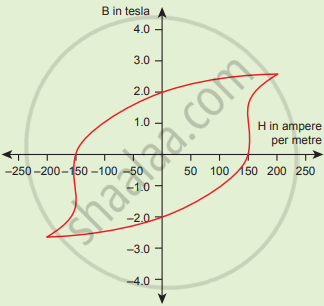Advertisements
Advertisements
Question
Compare the properties of soft and hard ferromagnetic materials.
Solution
| Properties | Soft ferromagnetic materials | Hard ferromagnetic materials |
| 1. Absence of external field. | Magnetisation disappear | Magnetisation remains |
| 2. Area of the loop | Small | Large |
| 3. Retentivity | Low | High |
| 4. Coercivity | Low | High |
| 5. Susceptibility and magnetic permeability | High | Low |
| 6. Hysteresis loss | Less | More |
| 7. Uses | Solenoid core, transformer core, and electromagnets | Permanent magnet |
| 8. Examples | Soft iron, Mumetal, Stelloy, etc. | Steel, Alnico, Lodestone, etc. |
APPEARS IN
RELATED QUESTIONS
Write the type of magnetism observed when the magnetic moments are oppositely aligned and cancel out each other.
Explain the following with suitable examples: Antiferromagnetism
Out of [CoF6]3- and [Co(en)3]3+, which one complex is
(i) paramagnetic
(ii) more stable
(iii) inner orbital complex and
(iv) high spin complex
(Atomic no. of Co = 27)
The BH curve for a ferromagnetic material is shown in the figure. The material is placed inside a long solenoid which contains 1000 turns/cm. The current that should be passed in the solenonid to demagnetize the ferromagnet completely is

What is magnetic susceptibility?
Fe3O4 (magnetite) is an example of ___________.
Which of the following arrangements shows schematic alignment of magnetic moments of antiferromagnetic substances?
Which of the following statements is not true?
Which of the following is not a ferroelectric compound?
Give a reason for the following:
Cu+2 salts are paramagnetic, while Cu+ salts are diamagnetic.
